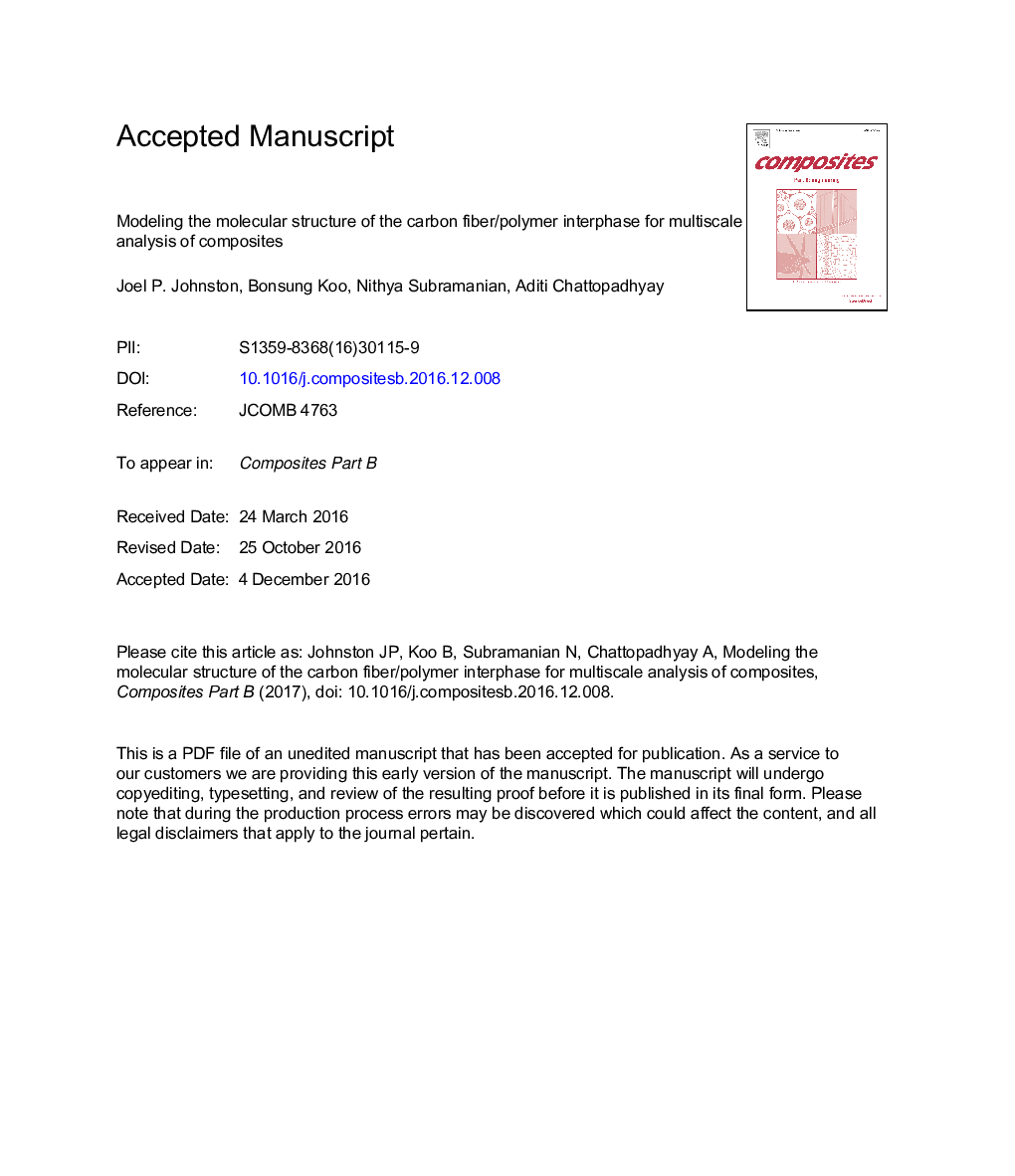| کد مقاله | کد نشریه | سال انتشار | مقاله انگلیسی | نسخه تمام متن |
|---|---|---|---|---|
| 5021507 | 1469374 | 2017 | 23 صفحه PDF | دانلود رایگان |
عنوان انگلیسی مقاله ISI
Modeling the molecular structure of the carbon fiber/polymer interphase for multiscale analysis of composites
ترجمه فارسی عنوان
مدلسازی ساختار مولکولی فیبر کربن / اینترفاز پلیمر برای تحلیل چند بعدی کامپوزیت
دانلود مقاله + سفارش ترجمه
دانلود مقاله ISI انگلیسی
رایگان برای ایرانیان
کلمات کلیدی
ترجمه چکیده
منطقه بین فاز ماتریس فیبر کربن / پلیمر نقش مهمی در رفتار و شکست آغاز کامپوزیت های ماتریس پلیمری ایفا می کند و برای بررسی اثرات این منطقه پیچیده بر پاسخ کامپوزیتی، نیاز به تکنیک های دقیق مدل سازی وجود دارد. این مقاله یک چارچوب مدل سازی چند محوری با وفاداری بالا و یکپارچه مدل جدید بین مولفه های بین مولفه ای برای تحلیل کامپوزیت های ماتریس پلیمری ارائه می دهد. مدل بین فاز، که شامل حفره ها در چند لایه گرافن می باشد، باعث نفوذ فیزیکی بین ماتریس پلیمری و سطح فیبر کربن می شود. حفره های موجود در لایه های گرافنی با هدف از بین بردن اتم های کربن تولید می شود که بهتر نشان دهنده بی نظمی بودن سطح فیبر کربن است. روش پویایی مولکولی خواص مکانیکی بین فاز در محدوده نانومواد را محاسبه می کند که در یک نظریه میکرومکنولوژی با وفاداری بالا ادغام می شود. علاوه بر این، تئوری های آسیب های پیشرفته و شکست در مقیاس های مختلف در چارچوب مدل سازی برای به دست آوردن شکست مقیاس وابسته به کامپوزیت استفاده می شود. مقایسه بین مدل بین فاز مولکولی فعلی و مدل های بین فاز موجود و آزمایش ها نشان می دهد که مدل فعلی، شیب تنش های بزرگتر را در میان فاز ماده ایجاد می کند. این گرادیان های استرس بزرگ باعث افزایش آسیب دیدگی و اثرات آسیب در فاز بینابینی می شوند که برای پیش بینی بهتر پاسخ های غیرخطی و آسیب های چند بعدی در مواد کامپوزیتی ضروری است.
موضوعات مرتبط
مهندسی و علوم پایه
سایر رشته های مهندسی
مهندسی (عمومی)
چکیده انگلیسی
The carbon fiber/polymer matrix interphase region plays an important role in the behavior and failure initiation of polymer matrix composites and accurate modeling techniques are needed to study the effects of this complex region on the composite response. This paper presents a high fidelity multiscale modeling framework integrating a novel molecular interphase model for the analysis of polymer matrix composites. The interphase model, consisting of voids in multiple graphene layers, enables the physical entanglement between the polymer matrix and the carbon fiber surface. The voids in the graphene layers are generated by intentionally removing carbon atoms, which better represents the irregularity of the carbon fiber surface. The molecular dynamics method calculates the interphase mechanical properties at the nanoscale, which are integrated within a high fidelity micromechanics theory. Additionally, progressive damage and failure theories are used at different scales in the modeling framework to capture scale-dependent failure of the composite. Comparisons between the current molecular interphase model and existing interphase models and experiments demonstrate that the current model captures larger stress gradients across the material interphase. These large stress gradients increase the viscoplasticity and damage effects at the interphase which are necessary for improved prediction of the nonlinear response and multiscale damage in composite materials.
ناشر
Database: Elsevier - ScienceDirect (ساینس دایرکت)
Journal: Composites Part B: Engineering - Volume 111, 15 February 2017, Pages 27-36
Journal: Composites Part B: Engineering - Volume 111, 15 February 2017, Pages 27-36
نویسندگان
Joel P. Johnston, Bonsung Koo, Nithya Subramanian, Aditi Chattopadhyay,
